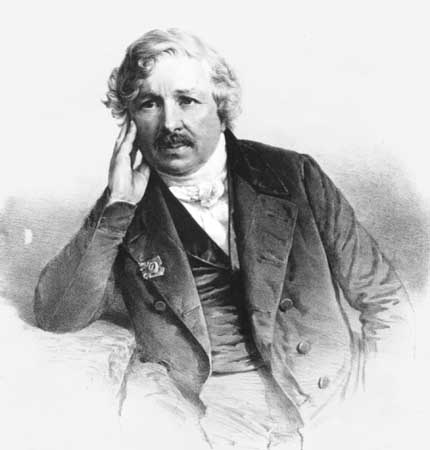Daguerre, Louis-Jacques-Mandé
French painter and physicist
born Nov. 18, 1787, Cormeilles, near Paris, France
died July 10, 1851, Bry-sur-Marne
 French painter and physicist who invented the first practical process of photography (photography, history of), known as the daguerreotype. Though the first permanent photograph from nature was made in 1826/27 by Nicéphore Niépce (Niépce, Nicéphore) of France, it was of poor quality and required about eight hours' exposure time. The process that Daguerre developed required only 20 to 30 minutes.
French painter and physicist who invented the first practical process of photography (photography, history of), known as the daguerreotype. Though the first permanent photograph from nature was made in 1826/27 by Nicéphore Niépce (Niépce, Nicéphore) of France, it was of poor quality and required about eight hours' exposure time. The process that Daguerre developed required only 20 to 30 minutes.Daguerre was at first an inland revenue officer and then a scene painter for the opera. In 1822 at Paris he opened the Diorama, an exhibition of pictorial views, with various effects induced by changes in the lighting. A similar establishment that he opened in Regent's Park, London, was destroyed by fire in 1839. Niépce, who since 1814 had been attempting to obtain permanent pictures by the action of sunlight, learned in 1826 of Daguerre's efforts in the same field. The two became partners in the development of Niépce's heliographic process from 1829 until the death of Niépce in 1833. Daguerre continued his experiments, and it was he who discovered that exposing an iodized silver plate in a camera would result in a lasting image if the latent image on the plate was developed by exposure to fumes of mercury and then fixed (made permanent) by a solution of common salt. On Jan. 9, 1839, a full description of his daguerreotype process was announced at a meeting of the Academy of Sciences by the eminent astronomer and physicist François Arago (Arago, François). Daguerre was appointed an officer of the Legion of Honour. In 1839 Daguerre and the heir of Niépce were assigned annuities of 6,000 francs and 4,000 francs, respectively, in return for their photographic process.
Additional Reading
Helmut Gernsheim and Alison Gernsheim, L.J.M. Daguerre: The History of the Diorama and the Daguerreotype (1968; rev. ed., with a new preface by the authors, of L.J.M. Daguerre (1787–1851), The World's First Photographer, 1956).
- Stanley Ketchel
- Stanley Kramer
- Stanley Kubrick
- Stanley Kunitz
- Stanley Marcus
- Stanley Matthews
- Stanley Melbourne Bruce Bruce, Viscount
- Stanley Melbourne Bruce, Viscount Bruce
- Stanley Middleton
- Stanley Morison
- Stanley, Sir Henry Morton
- Stanley, Thomas
- Stanley Tigerman
- Stanley, Wendell Meredith
- Stanley William Hayter
- Stan Musial
- stannite
- Stanovoy Range
- Stans
- Stans, Diet of
- Stanthorpe
- Stanton, Edwin M
- Stanton, Elizabeth Cady
- Stanton, Frank
- Stanton Macdonald-Wright